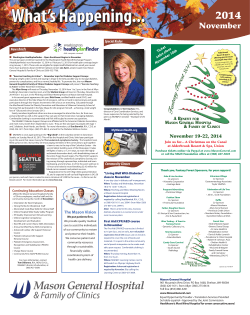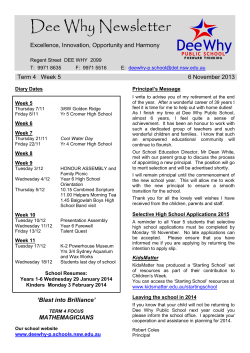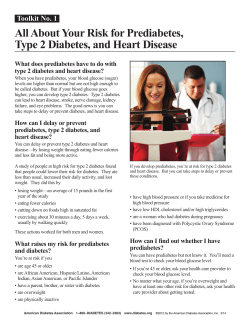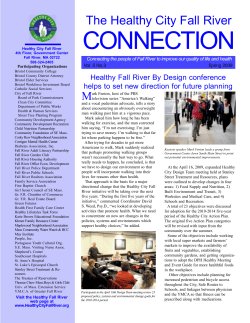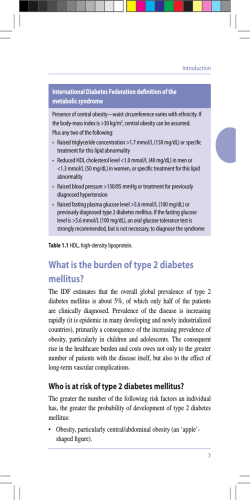
Type 2 diabetes - American Diabetes Association
STOPPING DIABETES STARTS NOW TOPICS • What is Diabetes? • Diabetes Epidemic • Risk Factors • Complications of Diabetes • Preventing Diabetes Complications DIABETES What is Diabetes? • The body does not produce or properly use insulin. • Insulin is a hormone that allows the body to use glucose for energy. The body produces glucose from the food you eat. TYPES OF DIABETES Type 1 diabetes • Usually diagnosed in children and young adults Type 2 diabetes • Most common form • Most often diagnosed in adults PREDIABETES What is Prediabetes? • Comes before type 2 diabetes • Blood glucose is higher than normal, but not yet diabetes • Most people with prediabetes don’t know they have it Prediabetes Ranges A1C 5.7-6.4% Fasting Plasma Glucose Test 100-125 mg/dl Oral Glucose 140-199 Tolerance Test mg/dl THE SCOPE OF DIABETES • Nearly 30 million Americans have diabetes, including 8.1 million who don’t know it. • Nearly 2 million new cases of diabetes are diagnosed each year. • 86 million Americans have prediabetes. THE SCOPE OF DIABETES Recent estimates project that as many as 1 in 3 American adults will have diabetes in 2050 unless we take steps to Stop Diabetes. THE SCOPE OF DIABETES County-level Estimates of Diagnosed Diabetes for Adults aged ≥ 20 years: United States 2011 From the Centers for Disease Control and Prevention: National Diabetes Surveillance System. *Map and Data provided by the Centers for Disease Control DIABETES IS COSTLY $ The American Diabetes Association estimates that the total national cost of diagnosed diabetes in the United States is $245 billion. $ Direct medical costs reach $176 billion and the average medical expenditure among people with diabetes is 2.3 times higher than those without the disease. $ Indirect costs amount to $69 billion (disability, work loss, premature mortality). $ One in 10 health care dollars is spent treating diabetes and its complications. $ One in five health care dollars is spent caring for people with diabetes. YOU ARE AT INCREASED RISK FOR DIABETES IF • • • • • • • • You are overweight. You are physically inactive. A parent, brother or sister has diabetes. You are African American, Hispanic/Latino, Native American, Asian American or Pacific Islander. You had a baby weighing more than 9 pounds or had gestational diabetes. You have high blood pressure. You have low HDL (good cholesterol). You have high triglycerides. DIABETES COMPLICATIONS Heart Attack and Stroke • Hospitalization rates for heart attack were 1.8 times higher among adults with diagnosed diabetes than among adults without diagnosed diabetes. • Hospitalization rates for stroke were 1.5 times higher among adults with diagnosed diabetes compared to those without diagnosed diabetes. DIABETES COMPLICATIONS Kidney Disease • Diabetes is the leading cause of kidney failure, accounting for 44 percent of new cases in 2011. • In 2011, 49,677 people with diabetes began treatment for end-stage renal disease. DIABETES COMPLICATIONS Amputations • About 60 percent of nontraumatic lower-limb amputations occur in people with diabetes. • In 2010, about 73,000 nontraumatic lower-limb amputations were performed in adults with diabetes. DIABETES COMPLICATIONS Blindness • Diabetes is the leading cause of new cases of blindness among adults aged 20-74 years. • In 2005-2008, 4.2 million (28.5 percent) people with diabetes aged 40 years or older had diabetic retinopathy, and of these, 655,000 (4.4 percent of those with diabetes) had advanced diabetic retinopathy that could lead to severe vision loss. PREVENTING COMPLICATIONS By managing the ABCs of diabetes, people with diabetes can reduce their risk of complications. A stands for A1C (a measure of average blood glucose) B stands for Blood pressure C stands for Cholesterol ASK ABOUT YOUR A1C • A1C measures average blood glucose over the last three months. • Get your A1C checked at least twice a year. • Talk to your health care team about what A1C goal is right for you. The goal for most people with diabetes is an A1C of less than 7 percent, which is an estimated Average Glucose (eAG) of 154mg/dl eAG - Another Way to Report A1C • Estimated Average Glucose, eAG, converts A1C into an average glucose value • eAG is reported in mg/dl, the same units used in glucose meters • An A1C of 7 percent translates into an eAG of 154 mg/dl BEWARE OF YOUR BLOOD PRESSURE • High blood pressure raises your risk for heart attack, stroke, eye problems and kidney disease. • Get your blood pressure checked at every visit. Target BP for people with diabetes = less than 140/80 KEY STEPS FOR LOWERING BLOOD PRESSURE • Cut back on salt. • Lose weight. • Quit smoking. • Cut back on alcohol if you have more than 1-2 drinks per day. • Take blood pressure pills prescribed by your doctor. • Exercise. CHECK YOUR CHOLESTEROL Several kinds of blood fats: • LDL (“bad”) cholesterol - can narrow or block blood vessels. • HDL (“good”) cholesterol - helps remove cholesterol deposits. • Triglycerides - can raise your risk for heart attacks/stroke. ADA GOALS FOR CHOLESTEROL • Target LDL = less than 100 • Desirable HDL = above 40 (men) above 50 (women) • Desirable triglycerides = less than 150 KEY STEPS FOR MANAGING CHOLESTEROL • Eat less saturated fat and trans fat. Foods high in saturated fat and trans fat: fatty meats, hot dogs, high fat dairy products like cream and cheese, baked products and snacks with hydrogenated vegetables oils in the ingredients. • Eat foods high in fiber. Examples: oatmeal, beans, peas, citrus fruits • Take cholesterol-lowering medication prescribed by your doctor. • Exercise regularly. MEAL PLANNING Work with a dietitian to develop your own, personalized meal plan to help you: • Lose weight, if needed. • Choose foods low in fat. • Include variety in your food choices (whole grains, vegetables, fruits, meats and dairy). EXERCISE A little bit goes a long way: • Try being more active throughout the day. Examples: work in the garden, play with the kids, take the stairs • Walk - work up to at least 30 minutes of walking on most days; you can even split this into three 10-minute walks when it’s convenient. OTHER STRATEGIES • Get help to quit smoking. • Talk to your health care provider about taking aspirin and other medications to reduce your risk for heart disease and stroke. MANAGING MEDICATIONS • Ask when to take each medicine; make sure instructions and labels are clear. • Link as many medicines as possible to recurring daily events – getting up, eating, brushing teeth, bedtime. • Set your watch, computer or a kitchen timer as a reminder. • Make a chart showing when each medicine should be taken. • Talk to your health care provider about what you should do if you miss a dose. • Use a daily or weekly pill box. • Put a reminder note where you’ll see it. GENERAL TIPS Take steps to lower your risk of diabetes complications: • A1C < 7, which is an estimated average glucose of 154 mg/dl • Blood pressure < 140/80 • Most adults with diabetes should consider statin therapy. • Get help to quit smoking. • Be active. • Make healthy food choices. • Talk to your doctor about medication. AMERICA GETS COOKING™ TO STOP DIABETES® During American Diabetes Month this November, the American Diabetes Association is encouraging you to start living a healthy, active lifestyle. America Gets Cooking to Stop Diabetes is presented by FOR INFORMATION,TIPS,RECIPES AND MORE 1-800-DIABETES DiabetesForecast.org/ADM
© Copyright 2026

